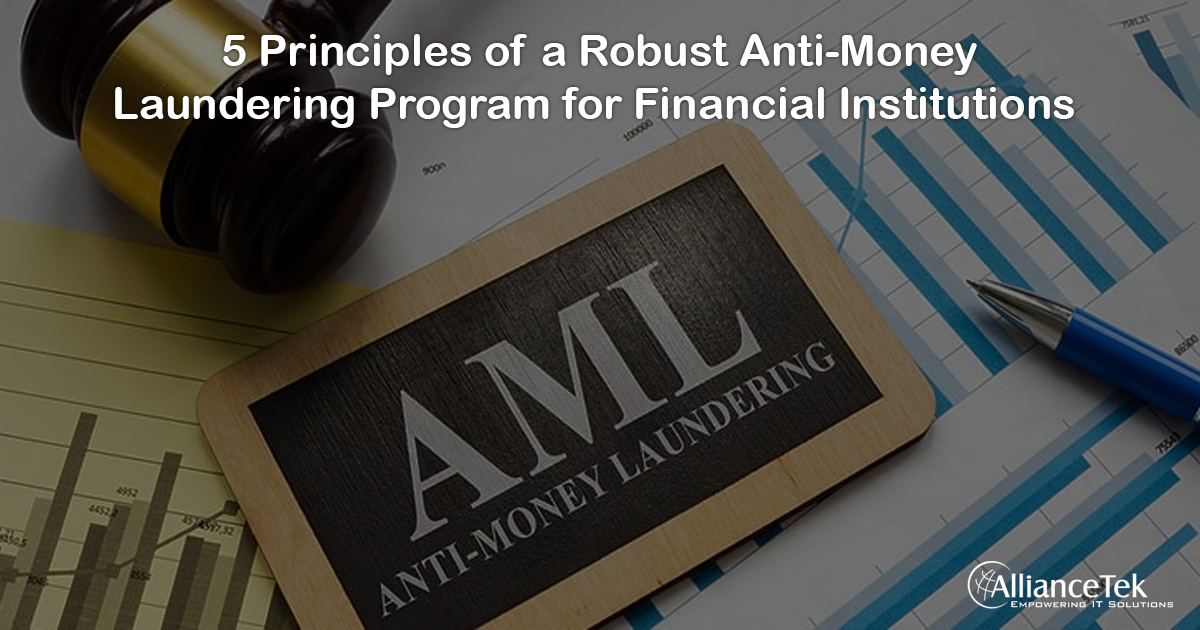Money laundering networks and terrorist financing rings are an increasing threat to the global financial sector. According to the United Nations Office on Drugs and Crime (UNODC), between 2% and 5% of global GDP (or between $800 million and $2 trillion) is laundered every year. But amidst the global financial crisis that emerged in the wake of the COVID-19 pandemic, bad actors from these disreputable organizations have had cause to celebrate. The general atmosphere of unpredictability has helped them hone their dark craft, and their methods grow more complex and elusive by the day.
Even if your own bank hasn’t been implicated in a major money laundering scandal, you wouldn’t want to anticipate the day when you and your customers have a rude awakening. It’s imperative that you guard your assets and your reputation through a robust and functional anti-money laundering program. Small banks, mid-sized banks, and large financial institutions alike can be guided by these five principles for an effective AML program. Make sure to incorporate these into your rulebook for responding to and preventing financial crime.

1. Evolve Faster Than Today’s Financial Criminals
To "Evolve faster than today's financial criminals" means that banks and financial institutions need to adopt a proactive approach to combat financial crime. It is no longer enough to simply respond to incidents after they happen or follow the money trail. Banks need to be able to anticipate and prevent criminal activity before it occurs.
This requires a combination of advanced technology and skilled personnel. Banks must invest in cutting-edge technologies such as artificial intelligence and machine learning to identify suspicious patterns and behaviours in real time. They must also continually update and evolve their AML programs and procedures to stay ahead of emerging threats.
Additionally, banks must prioritize the ongoing training and development of their AML staff. They need to hire experts with a deep understanding of financial crime and provide them with the necessary resources and support to stay up-to-date with the latest techniques and best practices.
By adopting a pre-emptive approach to AML, banks can protect themselves and their customers from the devastating consequences of financial crime. It is essential for financial institutions to remain vigilant and constantly evolve in order to stay ahead of the ever-evolving tactics of criminals.
2. Achieve a 360-Degree Vantage Point
The second step in evolving faster than today's financial criminals is to invest in technology that provides a 360-degree view of all transactions. This means leveraging the power of augmented intelligence, consolidated AML data management, and real-time monitoring to gain a comprehensive understanding of your organization's vulnerabilities to financial crime.
Having a horizontal or single-direction view of your AML situation is no longer sufficient. To effectively combat financial crime, banks need to have a complete, holistic view of their organization's transactions, customers, and activities. This requires consolidating data from multiple sources, including internal systems, external databases, and public records.
By utilizing augmented intelligence and real-time monitoring, banks can identify suspicious patterns and behaviours in real time, enabling them to take action before a crime occurs. This approach also enables banks to implement major AML-related decisions with greater accuracy and timeliness, reducing the risk of false positives and improving overall efficiency.
Furthermore, having a 360-degree view of your organization's transactions can help you identify potential areas of vulnerability and proactively address them before they become a problem. It also enables you to assess the effectiveness of your AML program and make data-driven decisions to improve its performance.
3. Adopt Pattern-Based Thinking Instead of Flagging False Positives Piecemeal
The traditional methods for tagging suspicious activity in AML programs are often slow, expensive, and time-consuming, making them ineffective against the fast-paced and ever-changing tactics of financial criminals. This means that relying on the piecemeal classification of false positives is no longer enough to combat financial crime. Banks need to adopt intelligent, pattern-based detection methodologies to detect and prevent illicit transactions.
Pattern-based detection methods allow banks to identify hidden relationships and behaviour patterns that may signal money laundering or other forms of financial crime. These methods are more effective than traditional rule-based systems, as they can detect emerging patterns and adapt to new threats.
Some examples of tools that can help you adjust to a pattern-based perspective are the following:
- Models
- Graph analytics
- Assignment of risk attributes
- Risk scoring
- Automated screening of appearances on blacklists or sanction lists
Investing in advanced AML technology is essential to surpassing current limits on sorting, tagging, and responding to cases of note. Banks must prioritize the adoption of intelligent, pattern-based detection methodologies to stay ahead of financial criminals and prevent financial crime from occurring.
4. Be Conscientious about Regulatory Compliance
Although bankers may not always see their regulators as allies, they play a crucial role in overseeing frameworks for modernizing banks and aligning their AML initiatives with global standards. Regulators are responsible for enforcing AML regulations and ensuring that financial institutions are implementing effective AML programs. By working closely with regulators, banks can make a long-term positive impact on their AML program and prevent financial crime.
Regulatory compliance is essential for the effective functioning of AML programs. Banks must comply with regulations, such as the Bank Secrecy Act (BSA) and the Financial Action Task Force (FATF) recommendations, to prevent financial crime and protect their institutions from regulatory penalties. Improving compliance infrastructure, such as the quality, thoroughness, and timeliness of AML reporting, can help banks stay on top of regulatory requirements and better prevent financial crime.
By seeing regulators as partners in crime prevention, banks can benefit from a more collaborative approach to AML compliance. This involves engaging with regulators to understand their expectations, proactively addressing compliance issues, and sharing best practices with industry peers.
In addition, a strong relationship with regulators can help banks innovate their financial technologies. Regulators can provide guidance on the use of emerging technologies in AML programs, such as artificial intelligence and blockchain, and help banks navigate the regulatory implications of implementing these technologies.
5. Never Lose Perspective of Your Legitimate Customers
The last principle that should be a cornerstone of any effective AML program is to prioritize the satisfaction of legitimate customers. While implementing customer due diligence and case management is crucial for preventing financial crime, banks must also ensure that these measures do not alienate customers with legitimate businesses.
Banks must strike a balance between detecting and preventing financial crime while providing a smooth, safe, and frictionless service to their customers. Customers should not feel burdened or inconvenienced by AML measures. Instead, banks must prioritize customer experience and satisfaction while implementing AML measures.
To achieve this, banks can use customer-centric approaches in their AML programs, such as simplifying customer onboarding processes, offering self-service options, and minimizing disruptions to legitimate transactions. Additionally, banks can provide clear and transparent communication to customers about AML measures and how they are being implemented to prevent financial crime.
A successful AML program must be designed to protect customers from financial crime while maintaining customer trust and satisfaction. By prioritizing customer experience and satisfaction, banks can build stronger relationships with their customers and differentiate themselves in a competitive marketplace.
Final Words
In summary, a successful AML program requires banks to adopt a proactive approach to combat financial crime. This involves improving visibility over transactions, applying pattern-based thinking, and staying several steps ahead of criminals. A complacent attitude towards financial crime can put the bank and its customers at risk, making it crucial to retool the AML program as necessary.
A successful AML program is essential for the stability and security of financial institutions. Banks must adopt a proactive approach to combat financial crime, improve visibility over transactions, apply pattern-based thinking, and stay several steps ahead of criminals. They must also prioritize customer satisfaction and differentiate themselves in a competitive marketplace.
Call us at 484-892-5713 or Contact Us today to know more details about the 5 Principles of a Robust Anti-Money Laundering Program for Financial Institutions


